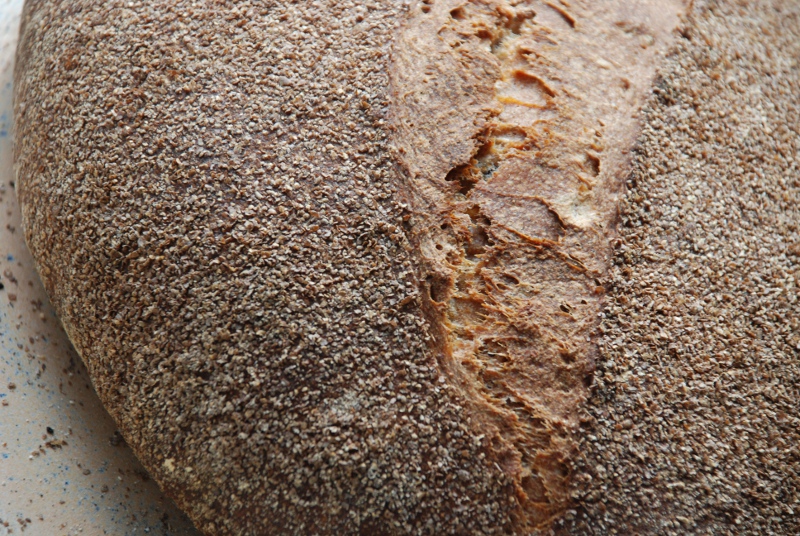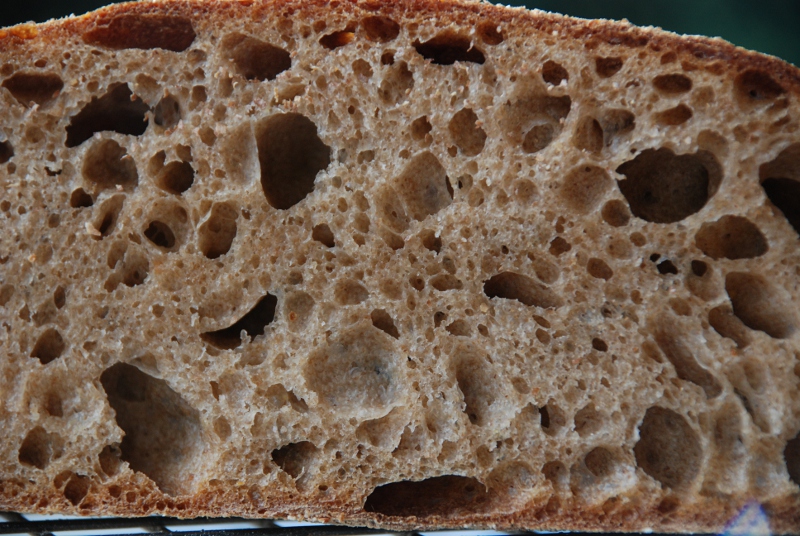
No not a publishing company, or a fancy new German housewares line - just a humble cobbler's loaf and miller's miche.
Continuing on with trying to absorb the King Arthur rye class I took a few weeks ago, I decided to make a Schuster Laib, or cobbler's loaf. Mr. Hamelman explained that this upside down rye loaf was probably originally some apprentice baker's error and so the head baker called it a cobbler's loaf, because for some reason, calling someone a cobbler was a big insult. Now of course, cobbler's loaves are made on purpose, and I've always gasped in admiration whenever I saw one. (Breadsong's version comes to mind.) At our class, while we were making the 80% rye loaves with rye soaker in Pullman pans, Mr. Hamelman quietly put one of these together. So this time, I made an 80% rye loaf as a free standing upside down hearth loaf.

At the class we had to sign (at least in our minds) an affidavit promising not to cut into the 80% loaves for 24 hours. So I can't get a look inside just yet, as it's only been around 4.
Update: So I had a few people over this morning and served the bread (they were expecting maybe coffee cake?) and they liked it, so I hacked it up to give them some to take home, almost forgetting that I owed a crumb shot. Fortunately there was a little bit left.

The flavor was very intense - that rye sour smell that I've been talking about transformed to taste. As much flavor as you'll ever get from flour and water.

So as not to have a day go by without bread, I decided to make a second loaf today. My home-milled flour has been getting cranky, as I make one rye loaf after another, so I decided to pull it out of the closet and take it for a spin. Loaf two is a miller's miche, so called because I used my home milled and sifted flour for the final dough, and sprinkled the whole loaf with the sifted and remilled bran.

The dough was so sticky when I flipped it out of the basket using my hand to steady it onto the peel, that it stuck to my hand, and I had to scrape it off and pat the loaf back together, so I was expecting a disaster. It recovered quite nicely in the oven, though, and is happily edible by humans.

The rye loaf was made with my new twice daily fed rye sour, and the miller's loaf was made with twice daily fed white starter. For today's bake, I finally got the smell that I remembered from the rye sour at King Arthur, although much less overpowering, as much smaller quantity. My wheat starter seems happier and more active as well, so I'm happy with the new regimen.
I used the exact formula from the class for the 80% rye, but modified process a bit to suit my baking conditions. I will list what I did rather than Mr. Hamelmans precise instructions.
Formulas and methods:
Schuster's Laib
|
3/10/2013
|
|
1st feed
|
2nd feed
|
2nd feed
|
Total
|
|
Rye sour
|
|
12:30 PM
|
9:30 PM
|
9:30 PM
|
|
|
Seed
|
54
|
|
|
|
|
|
Whole Rye
|
28
|
100
|
-55
|
150
|
223
|
|
Water
|
26
|
82
|
-45
|
122
|
185
|
| |
|
|
|
|
408
|
|
Soaker
|
|
|
|
|
|
|
Coarse Rye
|
109
|
|
|
|
|
|
boiling water
|
164
|
|
|
|
|
| |
273
|
|
|
|
|
| |
|
|
|
|
|
|
3/11/2013
|
Final
|
Sour
|
Soaker
|
Total
|
Percent
|
|
Whole Rye
|
137
|
192
|
109
|
438
|
80%
|
|
Sir Lancelot high gluten
|
109
|
|
|
109
|
20%
|
|
Water
|
153
|
158
|
164
|
475
|
87%
|
|
Salt
|
10
|
|
|
10
|
1.8%
|
|
Yeast
|
5
|
|
|
5
|
1.0%
|
|
Sour
|
350
|
|
|
|
|
|
Soaker
|
273
|
|
|
|
|
| |
|
|
|
|
|
|
Rye Sour seed hydration
|
|
|
90%
|
|
|
|
Rye Sour hydration
|
|
|
83%
|
|
|
|
Starter factor
|
|
|
0.86
|
|
|
|
Total Flour
|
|
|
547
|
|
|
|
Total Whole Grain
|
|
|
80%
|
|
|
|
Total Dough
|
|
|
1037
|
|
|
|
Percent prefermented flour
|
|
35%
|
|
|
|
Hydration
|
|
|
87%
|
|
|
| |
|
|
|
|
|
|
Build rye sour as listed. Sprinkle top with rye flour after 2nd build
|
|
|
Make soaker at the same time as final sour build
|
|
|
|
After 12 hours when sour is ripe (smell, and islands of the sprinkled rye flour)
|
|
mix all ingredients. Consistency is paste.
|
|
|
|
|
Bulk Ferment 30 minutes. Shape sprinkling top with rye after folding in
|
|
each corner. Place seam side down in lined basket.
|
|
|
|
Proof 1 hour 45 minutes.
|
|
|
|
|
|
|
Preheat oven to 550 for one hour (plus) with stone and large cast iron pan
|
|
Turn oven off, load loaf, and pour water into cast iron pan. Close oven and
|
|
listen. If hissing stops before 5 minutes is up, add water. After five minutes,
|
|
turn oven to 470F for 15 minutes. Then reduce heat to 440 for 40 minutes.
|
|
Remove and cool.
|
|
|
|
|
|
|
When cool wrap for overnight.
|
|
|
|
|
|
|
|
|
|
|
Miller’s Miche
|
3/10/2013
|
|
1st feed
|
Total
|
|
|
| |
|
9:30 PM
|
|
|
|
|
Seed
|
43
|
|
|
|
|
|
KAAP
|
25
|
118
|
143
|
|
|
|
Whole Rye
|
1
|
7
|
8
|
|
|
|
Water
|
17
|
84
|
101
|
67%
|
|
| |
|
|
252
|
|
|
|
3/11/2013
|
|
|
|
|
|
| |
Final
|
Starter
|
Sour
|
Total
|
Percent
|
|
KAAP
|
|
130
|
|
130
|
21%
|
|
Whole Rye
|
|
8
|
22
|
29
|
5%
|
|
Golden
|
450
|
|
|
450
|
74%
|
|
Water
|
350
|
92
|
18
|
461
|
76%
|
|
Salt
|
11
|
|
|
11
|
1.8%
|
|
Starter
|
230
|
|
|
|
|
|
Rye Sour
|
40
|
|
|
|
|
| |
|
|
|
|
|
| |
|
|
|
|
|
|
Starter seed hydration
|
|
67%
|
|
|
|
Starter hydration
|
|
67%
|
|
|
|
Starter factor
|
|
|
0.9
|
|
|
|
Total Flour
|
|
|
609
|
|
|
|
Total Whole Grain
|
|
79%
|
|
|
|
Total Dough
|
|
|
1081
|
|
|
|
Percent prefermented flour
|
26%
|
|
|
|
Hydration
|
|
|
76%
|
|
|
| |
|
|
|
|
|
| |
|
|
|
|
|
|
Autolyse flour and water 30 minutes
|
|
|
|
|
Add remaining ingredients and mix at speeds 1 and 2
|
|
|
to medium development
|
|
|
|
|
|
Rest 5 minutes. Stretch and fold in bowl.
|
|
|
|
Bulk Ferment 2 hours.
|
|
|
|
|
|
Shape into boule and place in lined basket.
|
|
|
|
Proof for 1.5 hours.
|
|
|
|
|
|
Bake at 450 with steam (cast iron method - see above) for 5 minutes
|
|
without for 40.
|
|
|
|
|
|
Remove and cool.
|
|
|
|
|
| |
|
|
|
|
|
|
Note that Rye Sour is leftover from the Rye loaf.
|
|